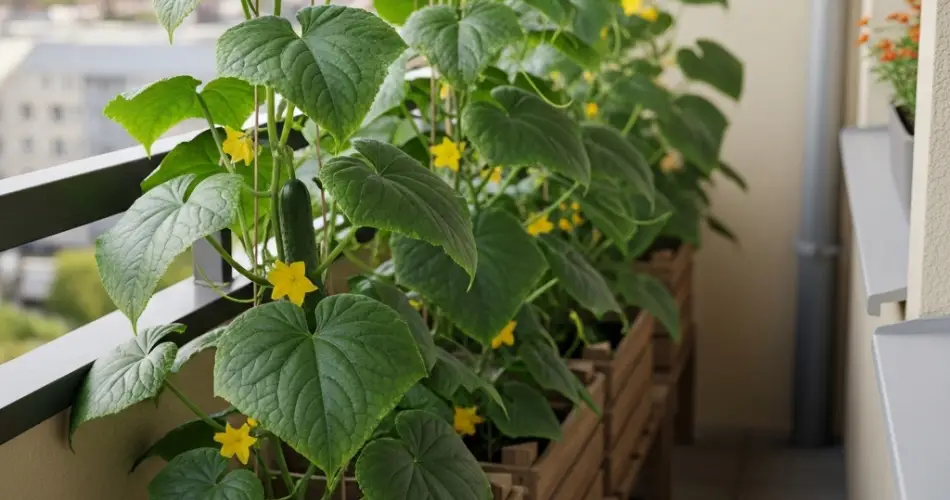Cucumbers are one of the most refreshing vegetables to grow at home, especially during warm seasons. While they traditionally need lots of space, vining cucumber varieties adapt very well to crate gardening—even on a balcony. With a sturdy crate, quality soil, and vertical support, you can enjoy an abundant harvest of crisp cucumbers from a compact, sunny corner of your home.
This method of growing cucumbers is ideal for urban dwellers who want to make the most of limited space while enjoying fresh produce throughout the season.
Why Choose Vining Cucumbers for Crate Gardening?
Vining cucumber plants naturally climb, making them perfect for vertical gardens. Training them upward using a trellis or netting saves floor space and improves air circulation, helping to prevent disease.
Benefits of growing cucumbers in crates include:
-
Efficient use of space – Maximize small balconies by growing vertically
-
Healthy root development – Crates offer deep, loose soil for roots
-
Better fruit quality – Vines grow off the ground, reducing pests and rot
-
Easy maintenance – Easy to access and manage growth and harvest
-
Aesthetic value – Green vines create a lush, decorative display
Crate gardening offers structure and drainage, which are both essential for healthy cucumber growth.
Best Vining Cucumber Varieties for Containers
When selecting cucumber seeds, opt for vining or climbing varieties that are productive and suited for vertical growing in limited spaces.
Recommended varieties:
-
Marketmore 76 – Disease-resistant and produces long, dark green cucumbers
-
Straight Eight – Classic slicer with good yields and climbing habit
-
Lemon Cucumber – Round, yellow cucumbers with a sweet, mild flavor
-
Japanese Climbing – Excellent for trellising and has crisp texture
-
Poinsett 76 – Resistant to many common cucumber diseases
Avoid bush types for this method, as they are more compact and not ideal for climbing structures.
What You’ll Need
To set up your crate cucumber garden, gather the following supplies:
-
A wooden or plastic crate at least 12–16 inches deep
-
Landscape fabric or newspaper to line the crate
-
High-quality potting mix with compost and perlite or coco coir
-
Vining cucumber seeds or healthy seedlings
-
Trellis, bamboo stakes, or vertical netting
-
Watering can or hose with fine spray
-
Organic fertilizer for vegetables
-
A sunny balcony spot (6–8 hours of sunlight per day)
Make sure the crate has proper drainage holes at the bottom.
Step 1: Prepare the Crate
Line the inside of the crate with landscape fabric or a few layers of newspaper to keep soil contained while allowing water to drain.
Place the crate in a sunny spot on your balcony. Cucumbers need warmth and direct light to grow vigorously and produce quality fruit.
Fill the crate with loose, fertile potting mix, leaving about an inch below the rim.
Step 2: Planting Seeds or Seedlings
If planting seeds directly, sow them about 1 inch deep and 8–10 inches apart along one side of the crate—ideally near where you’ll install the trellis.
If using seedlings, transplant them gently into the soil, being careful not to disturb the roots.
Water thoroughly after planting to settle the soil.
Step 3: Set Up Vertical Support
Install your trellis or support system early to avoid damaging the roots later. Options include:
-
Wooden stakes with garden twine
-
Wire mesh or netting secured to a wall or railing
-
Bamboo teepees tied at the top
As vines grow, gently guide and tie them to the support with soft ties. This encourages upward growth and better exposure to sunlight.
Step 4: Watering and Feeding
Cucumbers require consistent watering. Keep the soil evenly moist but not soggy. Water at the base of the plant in the early morning or late afternoon to avoid evaporation.
Fertilize every 2–3 weeks with a balanced organic fertilizer or compost tea to encourage flowering and fruiting. Cucumbers are heavy feeders, so timely nutrition boosts yield.
Step 5: Maintenance and Pest Control
Check plants regularly for pests such as aphids, whiteflies, or cucumber beetles. Use insecticidal soap or neem oil to manage outbreaks naturally.
Remove yellowing or damaged leaves to keep the plant healthy and maintain airflow.
To encourage productivity, harvest cucumbers as soon as they reach a usable size. This signals the plant to produce more fruit.
Step 6: Harvesting Your Cucumbers
Depending on the variety, cucumbers are ready to harvest 50–70 days after planting. Harvest when the cucumbers are firm, green (or yellow, depending on the type), and smooth.
Use scissors or garden shears to cut the fruit from the vine to avoid damaging the plant.
Harvesting regularly promotes continuous production throughout the season.
Step 7: Replanting and Crate Rotation
After harvesting your final crop, remove old plants and refresh the crate soil with compost before replanting. You can rotate crops by growing leafy greens, beans, or herbs next.
Sanitize the crate and supports if reusing them to reduce the risk of disease in future plantings.
Final Thoughts
Growing vining cucumbers in crates on your balcony is a simple and productive way to enjoy fresh, homegrown vegetables even in limited space. With vertical gardening, proper soil, and consistent care, you’ll be surprised by how much yield you can get from just one crate.
This method not only saves space but also transforms your balcony into a lush, green corner full of life and flavor. Whether for salads, pickling, or snacking, your cucumbers will taste even better knowing they came from your own miniature garden.



